Jiajie Li
ActLoc: Learning to Localize on the Move via Active Viewpoint Selection
Aug 28, 2025Abstract:Reliable localization is critical for robot navigation, yet most existing systems implicitly assume that all viewing directions at a location are equally informative. In practice, localization becomes unreliable when the robot observes unmapped, ambiguous, or uninformative regions. To address this, we present ActLoc, an active viewpoint-aware planning framework for enhancing localization accuracy for general robot navigation tasks. At its core, ActLoc employs a largescale trained attention-based model for viewpoint selection. The model encodes a metric map and the camera poses used during map construction, and predicts localization accuracy across yaw and pitch directions at arbitrary 3D locations. These per-point accuracy distributions are incorporated into a path planner, enabling the robot to actively select camera orientations that maximize localization robustness while respecting task and motion constraints. ActLoc achieves stateof-the-art results on single-viewpoint selection and generalizes effectively to fulltrajectory planning. Its modular design makes it readily applicable to diverse robot navigation and inspection tasks.
Hardware-friendly IR-HARQ for Polar SCL Decoders
Aug 11, 2025Abstract:To extend the applications of polar codes within next-generation wireless communication systems, it is essential to incorporate support for Incremental Redundancy (IR) Hybrid Automatic Repeat Request (HARQ) schemes. The baseline IR-HARQ scheme's reliance on set-based operations leads to irregular memory access patterns, posing significant challenges for efficient hardware implementation. Furthermore, the introduction of new bit types increases the number of fast nodes that are decoded without traversing the sub-tree, resulting in a substantial area overhead when implemented in hardware. To address these issues and improve hardware compatibility, we propose transforming the set-based operations within the polar IR-HARQ scheme into binary vector operations. Additionally, we introduce a new fast node integration approach that avoids increasing the number of fast nodes, thereby minimizing the associated area overhead. Our proposed scheme results in a memory overhead of 25-27% compared to successive cancellation list (SCL) decoding without IR-HARQ support.
HeuriGym: An Agentic Benchmark for LLM-Crafted Heuristics in Combinatorial Optimization
Jun 09, 2025Abstract:While Large Language Models (LLMs) have demonstrated significant advancements in reasoning and agent-based problem-solving, current evaluation methodologies fail to adequately assess their capabilities: existing benchmarks either rely on closed-ended questions prone to saturation and memorization, or subjective comparisons that lack consistency and rigor. In this work, we introduce HeuriGym, an agentic framework designed for evaluating heuristic algorithms generated by LLMs for combinatorial optimization problems, characterized by clearly defined objectives and expansive solution spaces. HeuriGym empowers LLMs to propose heuristics, receive evaluative feedback via code execution, and iteratively refine their solutions. We evaluate nine state-of-the-art models on nine problems across domains such as computer systems, logistics, and biology, exposing persistent limitations in tool use, planning, and adaptive reasoning. To quantify performance, we propose the Quality-Yield Index (QYI), a metric that captures both solution pass rate and quality. Even top models like GPT-o4-mini-high and Gemini-2.5-Pro attain QYI scores of only 0.6, well below the expert baseline of 1. Our open-source benchmark aims to guide the development of LLMs toward more effective and realistic problem-solving in scientific and engineering domains.
HF-VTON: High-Fidelity Virtual Try-On via Consistent Geometric and Semantic Alignment
May 26, 2025Abstract:Virtual try-on technology has become increasingly important in the fashion and retail industries, enabling the generation of high-fidelity garment images that adapt seamlessly to target human models. While existing methods have achieved notable progress, they still face significant challenges in maintaining consistency across different poses. Specifically, geometric distortions lead to a lack of spatial consistency, mismatches in garment structure and texture across poses result in semantic inconsistency, and the loss or distortion of fine-grained details diminishes visual fidelity. To address these challenges, we propose HF-VTON, a novel framework that ensures high-fidelity virtual try-on performance across diverse poses. HF-VTON consists of three key modules: (1) the Appearance-Preserving Warp Alignment Module (APWAM), which aligns garments to human poses, addressing geometric deformations and ensuring spatial consistency; (2) the Semantic Representation and Comprehension Module (SRCM), which captures fine-grained garment attributes and multi-pose data to enhance semantic representation, maintaining structural, textural, and pattern consistency; and (3) the Multimodal Prior-Guided Appearance Generation Module (MPAGM), which integrates multimodal features and prior knowledge from pre-trained models to optimize appearance generation, ensuring both semantic and geometric consistency. Additionally, to overcome data limitations in existing benchmarks, we introduce the SAMP-VTONS dataset, featuring multi-pose pairs and rich textual annotations for a more comprehensive evaluation. Experimental results demonstrate that HF-VTON outperforms state-of-the-art methods on both VITON-HD and SAMP-VTONS, excelling in visual fidelity, semantic consistency, and detail preservation.
Towards Understanding Multi-Round Large Language Model Reasoning: Approximability, Learnability and Generalizability
Mar 05, 2025Abstract:Recent advancements in cognitive science and multi-round reasoning techniques for Large Language Models (LLMs) suggest that iterative thinking processes improve problem-solving performance in complex tasks. Inspired by this, approaches like Chain-of-Thought, debating, and self-refinement have been applied to auto-regressive LLMs, achieving significant successes in tasks such as mathematical reasoning, commonsense reasoning, and multi-hop question answering. Despite these successes, the theoretical basis for how multi-round reasoning enhances problem-solving abilities remains underexplored. In this work, we investigate the approximation, learnability, and generalization properties of multi-round auto-regressive models. We show that Transformers with finite context windows are universal approximators for steps of Turing-computable functions and can approximate any Turing-computable sequence-to-sequence function through multi-round reasoning. We extend PAC learning to sequence generation and demonstrate that multi-round generation is learnable even when the sequence length exceeds the model's context window. Finally, we examine how generalization error propagates across rounds, and show how the aforementioned approaches can help constrain this error, ensuring outputs stay within an expectation boundary. This work sheds light on the systemic theoretical foundations of multi-round sequence learning and reasoning, emphasizing its role in inference complexity.
Recognize Any Surgical Object: Unleashing the Power of Weakly-Supervised Data
Jan 25, 2025



Abstract:We present RASO, a foundation model designed to Recognize Any Surgical Object, offering robust open-set recognition capabilities across a broad range of surgical procedures and object classes, in both surgical images and videos. RASO leverages a novel weakly-supervised learning framework that generates tag-image-text pairs automatically from large-scale unannotated surgical lecture videos, significantly reducing the need for manual annotations. Our scalable data generation pipeline gatherers to 2,200 surgical procedures and produces 3.6 million tag annotations across 2,066 unique surgical tags. Our experiments show that RASO achieves improvements of 2.9 mAP, 4.5 mAP, 10.6 mAP, and 7.2 mAP on four standard surgical benchmarks respectively in zero-shot settings, and surpasses state-of-the-art models in supervised surgical action recognition tasks. We will open-source our code, model, and dataset to facilitate further research.
LLaVA-Surg: Towards Multimodal Surgical Assistant via Structured Surgical Video Learning
Aug 15, 2024



Abstract:Multimodal large language models (LLMs) have achieved notable success across various domains, while research in the medical field has largely focused on unimodal images. Meanwhile, current general-domain multimodal models for videos still lack the capabilities to understand and engage in conversations about surgical videos. One major contributing factor is the absence of datasets in the surgical field. In this paper, we create a new dataset, Surg-QA, consisting of 102,000 surgical video-instruction pairs, the largest of its kind so far. To build such a dataset, we propose a novel two-stage question-answer generation pipeline with LLM to learn surgical knowledge in a structured manner from the publicly available surgical lecture videos. The pipeline breaks down the generation process into two stages to significantly reduce the task complexity, allowing us to use a more affordable, locally deployed open-source LLM than the premium paid LLM services. It also mitigates the risk of LLM hallucinations during question-answer generation, thereby enhancing the overall quality of the generated data. We further train LLaVA-Surg, a novel vision-language conversational assistant capable of answering open-ended questions about surgical videos, on this Surg-QA dataset, and conduct comprehensive evaluations on zero-shot surgical video question-answering tasks. We show that LLaVA-Surg significantly outperforms all previous general-domain models, demonstrating exceptional multimodal conversational skills in answering open-ended questions about surgical videos. We will release our code, model, and the instruction-tuning dataset.
EgoGaussian: Dynamic Scene Understanding from Egocentric Video with 3D Gaussian Splatting
Jun 28, 2024

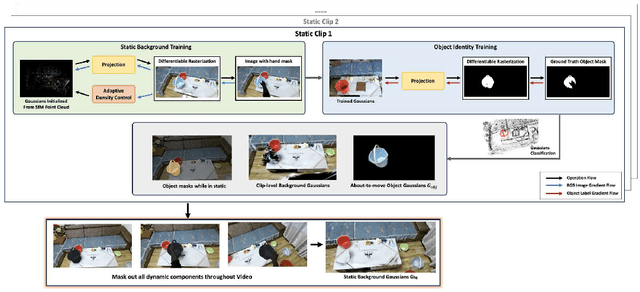

Abstract:Human activities are inherently complex, and even simple household tasks involve numerous object interactions. To better understand these activities and behaviors, it is crucial to model their dynamic interactions with the environment. The recent availability of affordable head-mounted cameras and egocentric data offers a more accessible and efficient means to understand dynamic human-object interactions in 3D environments. However, most existing methods for human activity modeling either focus on reconstructing 3D models of hand-object or human-scene interactions or on mapping 3D scenes, neglecting dynamic interactions with objects. The few existing solutions often require inputs from multiple sources, including multi-camera setups, depth-sensing cameras, or kinesthetic sensors. To this end, we introduce EgoGaussian, the first method capable of simultaneously reconstructing 3D scenes and dynamically tracking 3D object motion from RGB egocentric input alone. We leverage the uniquely discrete nature of Gaussian Splatting and segment dynamic interactions from the background. Our approach employs a clip-level online learning pipeline that leverages the dynamic nature of human activities, allowing us to reconstruct the temporal evolution of the scene in chronological order and track rigid object motion. Additionally, our method automatically segments object and background Gaussians, providing 3D representations for both static scenes and dynamic objects. EgoGaussian outperforms previous NeRF and Dynamic Gaussian methods in challenging in-the-wild videos and we also qualitatively demonstrate the high quality of the reconstructed models.
Large Language Models have Intrinsic Self-Correction Ability
Jun 21, 2024


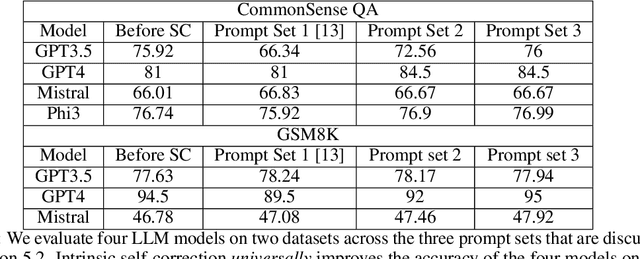
Abstract:Large language models (LLMs) have attracted significant attention for their remarkable abilities in various natural language processing tasks, but they suffer from hallucinations that will cause performance degradation. One promising solution to improve the LLMs' performance is to ask LLMs to revise their answer after generation, a technique known as self-correction. Among the two types of self-correction, intrinsic self-correction is considered a promising direction because it does not utilize external knowledge. However, recent works doubt the validity of LLM's ability to conduct intrinsic self-correction. In this paper, we present a novel perspective on the intrinsic self-correction capabilities of LLMs through theoretical analyses and empirical experiments. In addition, we identify two critical factors for successful self-correction: zero temperature and fair prompts. Leveraging these factors, we demonstrate that intrinsic self-correction ability is exhibited across multiple existing LLMs. Our findings offer insights into the fundamental theories underlying the self-correction behavior of LLMs and remark on the importance of unbiased prompts and zero temperature settings in harnessing their full potential.
Can We Enhance the Quality of Mobile Crowdsensing Data Without Ground Truth?
May 29, 2024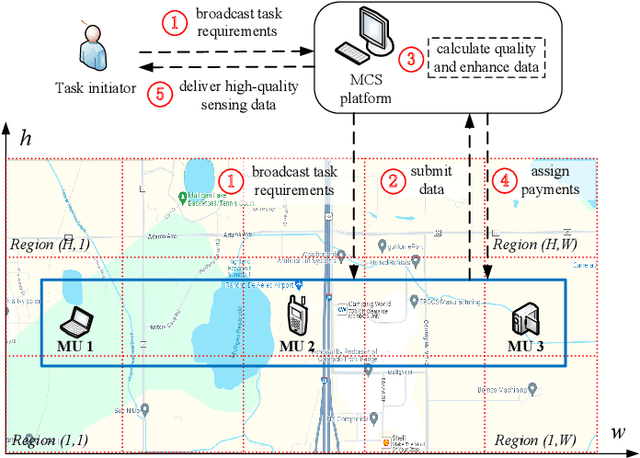
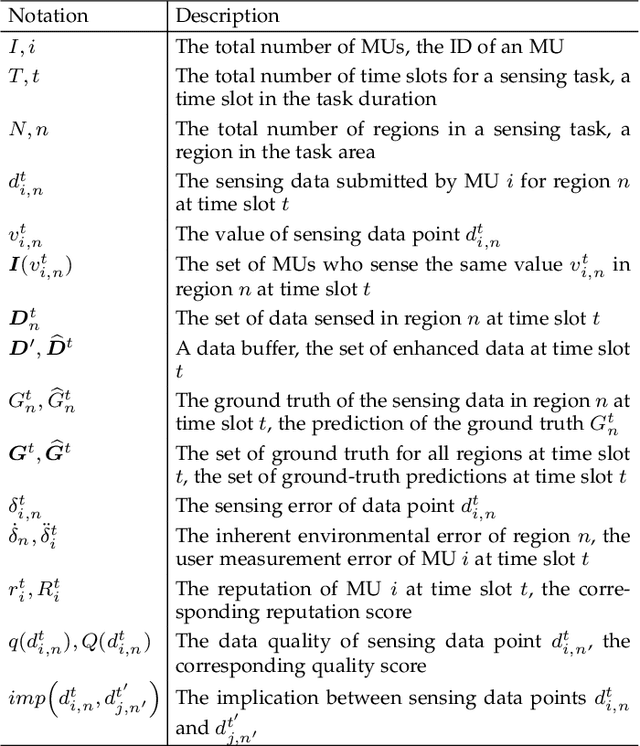
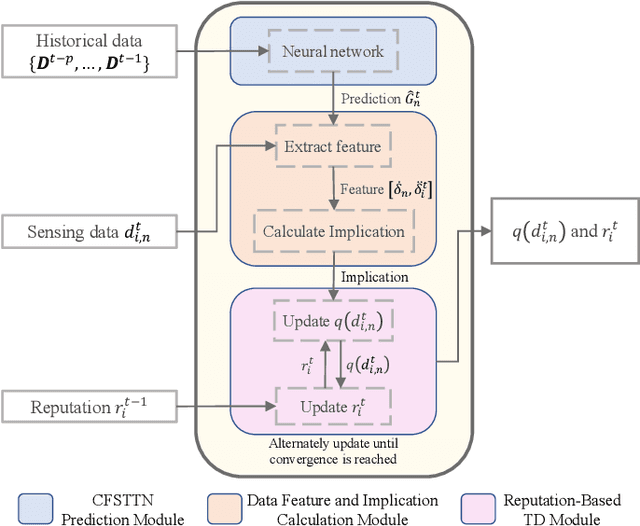
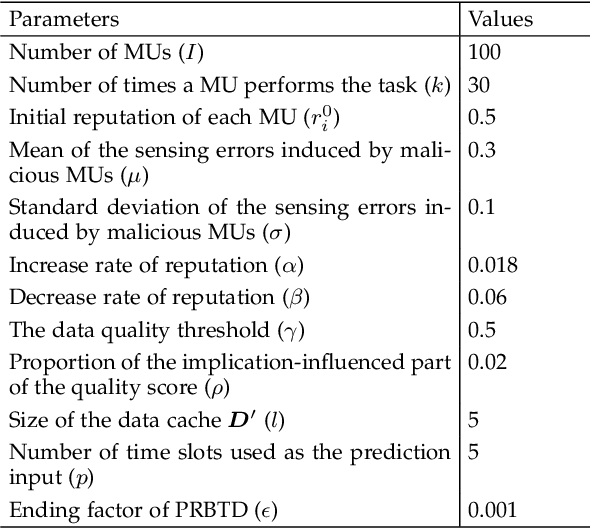
Abstract:Mobile crowdsensing (MCS) has emerged as a prominent trend across various domains. However, ensuring the quality of the sensing data submitted by mobile users (MUs) remains a complex and challenging problem. To address this challenge, an advanced method is required to detect low-quality sensing data and identify malicious MUs that may disrupt the normal operations of an MCS system. Therefore, this article proposes a prediction- and reputation-based truth discovery (PRBTD) framework, which can separate low-quality data from high-quality data in sensing tasks. First, we apply a correlation-focused spatial-temporal transformer network to predict the ground truth of the input sensing data. Then, we extract the sensing errors of the data as features based on the prediction results to calculate the implications among the data. Finally, we design a reputation-based truth discovery (TD) module for identifying low-quality data with their implications. Given sensing data submitted by MUs, PRBTD can eliminate the data with heavy noise and identify malicious MUs with high accuracy. Extensive experimental results demonstrate that PRBTD outperforms the existing methods in terms of identification accuracy and data quality enhancement.
 Add to Chrome
Add to Chrome Add to Firefox
Add to Firefox Add to Edge
Add to Edge